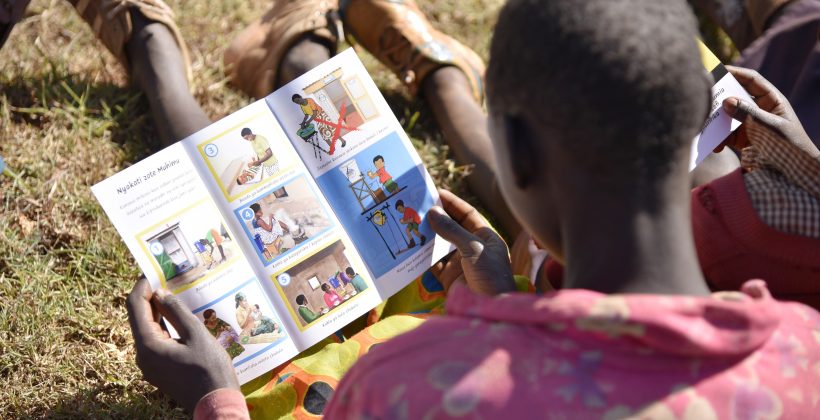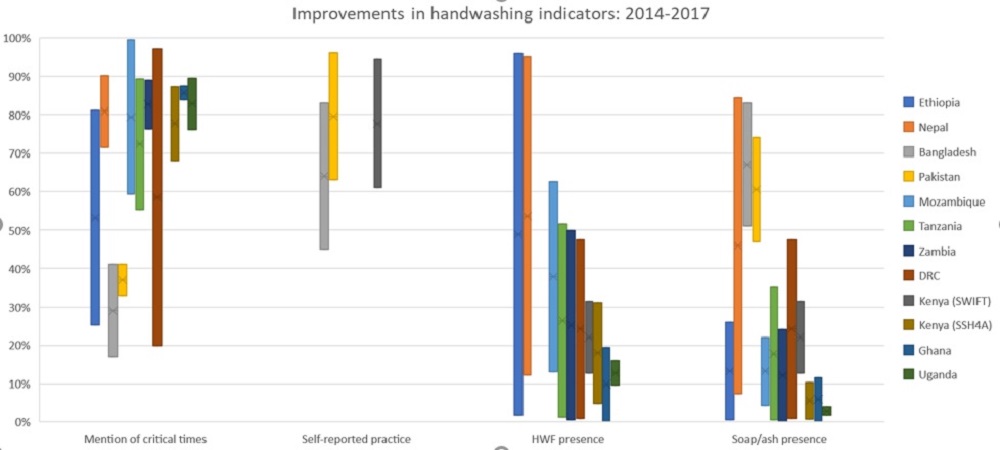
The WASH Results Programme reached 16.1 million people with hygiene messages over the course of seven years. The programme practised ‘payment by results’ – where hygiene outcomes were systematically measured before being paid for – an unusual and innovative practice in WASH programming. Setting hygiene outcome targets, related measurement frameworks, and levels of payment against these, was a controversial idea and led to intense discussions between (then) DFID and the NGO consortia implementing the programme.
Why was this set-up so controversial? First, handwashing with soap is a behaviour change which is hard to achieve in practice, particularly when water and soap are precious items. Second, changes in hygiene behaviour are notoriously difficult to measure. When hygiene outcome targets were being negotiated, there was little reference data to fall back on. In the face of so many unknowns, individually negotiated conservative outcome targets for hygiene ranged between 12-15% of those reached with hygiene messages.
In WASH Results, hygiene outcomes were typically assessed through a combination of people recalling critical times for handwashing and having a handwashing facility with water and soap (sometimes ash) on their premises, and, at times, also including self-reported practice or a demonstration. Results were typically measured one and two years after the implementation phase, and we’ve been able to draw some interesting highlights out of this work.
Handwashing in practice: what the data tells us
The programme was effective at getting hygiene messages across to people. The data (taken from the first phase of the programme – illustrated in the graph below with hygiene indicators at baseline and endline) shows that, on average, more than 80% of the people in programme areas reached with hygiene promotion activities across 11 countries remember the critical times for handwashing (up from 53% at baseline).

But, has this also resulted in actual handwashing? Here, the data shows an increase in handwashing facilities from 10% to 50% and an increase of soap from 6% to 38%. In other words, of the 80% who understand when to wash their hands, only 38% have soap and a handwashing facility at their disposal. This suggests two things. First, it confirms something that we know already: understanding the importance of washing your hands with soap does not necessarily translate into practice. Second, we need to set the bar higher in hygiene promotion to really understand what holds people back from washing their hands with soap.

There are other interesting details. For example, two country programmes, Bangladesh and Pakistan, reported much lower levels of knowledge (around 41%) compared to the average of 80%. This is, at least in part, related to how the indicator framework was designed in these two countries: people had to remember a higher number of ‘critical times’ for handwashing such as ‘after cleaning a child’s bottom’. There was also a gender dimension relating to who was being asked – men recalled fewer of the gender-sensitive critical handwashing times e.g. ‘before preparing food’.
Still, the impressive upward surge in handwashing facilities with soap is good news. It indicates a substantial increase in the number of people who are likely to wash their hands and thereby reduce their own and their families’ exposure to disease. It is much higher than the conservative target of 12-15% set at the programme level.
The rich data from the WASH Results Programme illustrates why we should put more emphasis on measuring and making sense of hygiene outcomes as part of WASH interventions. When measured at regular intervals, outcome data can highlight where hygiene promotion efforts are failing to have a sustainable impact on their target audiences and so enable programmes to adapt their approaches. If we want to achieve health outcomes, hygiene data needs to come front and centre. The renewed focus on handwashing as a result of COVID-19 offers the opportunity to do so.
To find out more, read our learning briefs on ‘‘Outcome achievements in the WASH Results Programme: data and insights’ and on ‘Setting and monitoring outcome targets‘.
To find out more about the Payment-by-Results mechanism, visit our blog.
And if you actively want to engage on this topic, please register for the upcoming RWSN webinar on ‘Achieving sustainable WASH at scale; lessons from an NGO-led Payment by Results Programme‘ on 10 November 2020.

